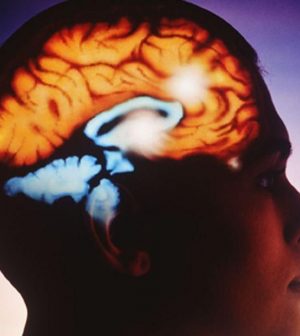- Skip Storing This Everyday Product in the Fridge Door
- Green Tea + B3 Pairing May Boost Brain Health
- Navigating Your Midlife Crisis: Embracing New Possibilities
- City Raccoons Showing Signs of Domestication
- Mapping the Exposome: Science Broadens Focus to Environmental Disease Triggers
- One Week Less on Social Media Linked to Better Mental Health
- Your Brain Changes in Stages as You Age, Study Finds
- Some Suicide Victims Show No Typical Warning Signs, Study Finds
- ByHeart Formula Faces Lawsuits After Babies Sickened With Botulism
- Switch to Vegan Diet Could Cut Your Greenhouse Gas Emissions in Half
Scientists Discover Rare Form of ALS That Can Strike Kids

A new form of amyotrophic lateral sclerosis (ALS) that affects children has been discovered by an international team of researchers.
They used advanced genetic techniques to identify 11 such cases in children who had mysterious neurological disorders.
Most cases of ALS — also known as Lou Gehrig’s disease — are diagnosed in people between the ages of 50 and 60, and it progresses so rapidly that patients typically die within three to five years.
But this newly identified form of ALS begins in childhood, progresses more slowly, and is linked with a gene called SPTLC1, which is part of the body’s fat production system. Preliminary results suggest that genetically silencing SPTLC1 activity may combat this type of ALS, according to the authors of the study.
“ALS is a paralyzing and often fatal disease that usually affects middle-aged people. We found that a genetic form of the disease can also threaten children. Our results show for the first time that ALS can be caused by changes in the way the body metabolizes lipids,” said study co-senior author Dr. Carsten Bonnemann, a senior investigator at the U.S. National Institute of Neurological Disorders and Stroke.
“These preliminary results suggest that we may be able to use a precision gene silencing strategy to treat patients with this type of ALS. In addition, we are also exploring other ways to step on the brake that slows SPT activity,” Bonnemann said in an institute news release. “Our ultimate goal is to translate these ideas into effective treatments for our patients who currently have no therapeutic options.”
Initial ALS symptoms in the 11 children appeared at about age 4. By the end of the study, they had lived from five to 20 years longer.
“These young patients had many of the upper and lower motor neuron problems that are indicative of ALS,” said study lead author Dr. Payam Mohassel, an NIH clinical research fellow. “What made these cases unique was the early age of onset and the slower progression of symptoms. This made us wonder what was underlying this distinct form of ALS.”
The study was published May 31 in the journal Nature Medicine.
More information
The U.S. National Institute of Neurological Disorders and Stroke has more on ALS.
SOURCE: U.S. National Institutes of Health/National Institute of Neurological Disorders and Stroke, news release, May 31, 2021
Source: HealthDay
Copyright © 2025 HealthDay. All rights reserved.










